
|
You entered: solar flare
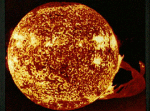 The Sun Erupts
The Sun Erupts
30.08.1998
The Sun is a seething ball of extremely hot gas. Above, the Sun was captured by Skylab in 1973 throwing off one the largest eruptive prominences in recorded history. The Sun has survived for about 5 billion years, and will likely survive for another 5 billion.
 Coronal Rain on the Sun
Coronal Rain on the Sun
27.05.2018
Does it rain on the Sun? Yes, although what falls is not water but extremely hot plasma. An example occurred in mid-July 2012 after an eruption on the Sun that produced both a Coronal Mass Ejection and a moderate solar flare. What was more unusual, however, was what happened next.
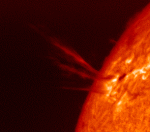 A Solar Corona Ejection
A Solar Corona Ejection
8.11.1996
The Sun would not be a nice place to spend the summer. One reason, besides the extreme heat, is that explosions are common there. In the above picture, magnetic fields buckle releasing previously constrained hot material from the upper atmosphere of the Sun.
 Coronal Rain on the Sun
Coronal Rain on the Sun
26.02.2013
Does it rain on the Sun? Yes, although what falls is not water but extremely hot plasma. An example occurred in mid-July 2012 after an eruption on the Sun that produced both a Coronal Mass Ejection and a moderate solar flare. What was more unusual, however, was what happened next.
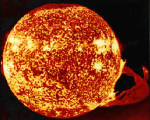 The Sun Erupts
The Sun Erupts
13.08.1995
The sun was captured in 1973 throwing one of the largest eruptive prominences ever recorded. Sol, our sun, is a normal star. It formed about 5 billion years ago, and will last about another 5 billion years. The sun will never explode, and a solar flare will never destroy the earth.
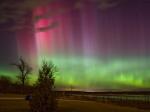 Aurora Over Iowa
Aurora Over Iowa
18.12.2006
Last Thursday evening, stars were not the only lights in Iowa skies. Spectacular northern lights also shone from the heavens, extending across the midwestern USA and other locations not often graced with auroral displays.
 Waterfalls, Auroras, Comet: Iceland
Waterfalls, Auroras, Comet: Iceland
26.03.2013
If not distracted by the picturesque landscape, waterfalls, stars, and auroras, you might be able to find Comet PANSTARRS. The above image, capturing multiple terrestrial and celestial wonders in a single shot, was taken last week in southwest Iceland.
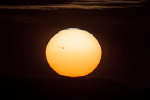 Sunspot at Sunset
Sunspot at Sunset
8.01.2014
Sunsets may be the most watched celestial event, but lately sunsets have even offered something extra. A sunspot so large it was visible to the naked eye is captured in Swiss skies in this...
 The Not So Quiet Sun
The Not So Quiet Sun
6.08.2010
After a long solar minimum, the Sun is no longer so quiet. On August 1, this extreme ultraviolet snapshot of the Sun from the Solar Dynanimcs Observatory captured a complex burst of activity playing across the Sun's northern hemisphere.
 Sunspot Region 30
Sunspot Region 30
18.07.2002
The solar active region designated number 0030 is now appearing on the visible hemisphere of the closest star. Dwarfed by the Sun's disk, the group of sunspots which make up region 30 actually cover an enormous area -- nearly 10 times the size of Earth.
|
January February March April |
|||||||||||||||||||||||||||||||||||||||||||||||||